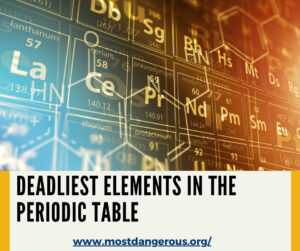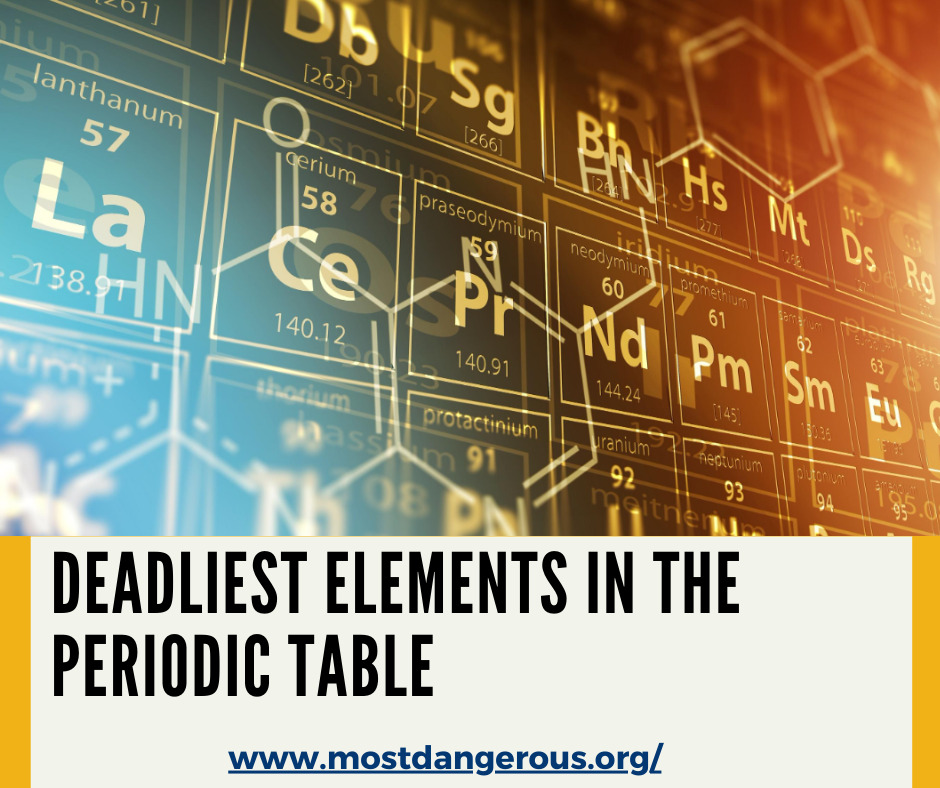Deadliest Elements in the Periodic Table.
Chemistry, the study of matter and its properties, encompasses a vast array of elements, each with its own unique characteristics and potential applications.
While many elements are essential for life and industry, others possess deadly properties that can pose serious risks to human health and the environment.

In this article, I’ll delve into the deadliest elements in the periodic table, exploring their lethal effects and the reasons behind their notoriety.
Top 8 Deadliest Elements in the Periodic Table
1. Polonium (Po)
Polonium is a highly radioactive element that emits alpha particles, making it extremely hazardous to human health.
Even small amounts of polonium exposure can lead to radiation poisoning and increase the risk of cancer.
Notable for its role in the assassination of Russian dissident Alexander Litvinenko in 2006, polonium is one of the deadliest elements known to man.
2. Plutonium (Pu)
Plutonium is a synthetic element commonly used in nuclear reactors and weapons. It is highly toxic and radioactive, posing significant health risks to those exposed to it.
Inhalation or ingestion of plutonium can lead to radiation sickness, organ damage, and an increased risk of cancer.
Due to its long half-life and potential for use in nuclear weapons, plutonium is considered one of the most dangerous elements on Earth.
3. Mercury (Hg)
Mercury is a naturally occurring metal that is toxic to humans and animals.
Exposure to mercury vapor or organic mercury compounds can lead to neurological damage, kidney failure, and death.
Despite its toxicity, mercury has been widely used in products such as thermometers, fluorescent lights, and dental fillings, posing significant environmental and health risks.
4. Arsenic (As)
Arsenic is a naturally occurring metalloid that is highly toxic in its inorganic form.
Chronic exposure to arsenic can lead to a range of health problems, including skin lesions, cardiovascular disease, and various types of cancer.
Arsenic contamination in drinking water and food sources remains a significant public health concern in many parts of the world.
5. Lead (Pb)
Lead is a heavy metal that is toxic to the nervous system, kidneys, and reproductive organs.
Exposure to lead can cause developmental delays in children, cognitive impairment, and an increased risk of heart disease and stroke in adults.
Despite widespread efforts to reduce lead exposure, it remains a significant environmental and health hazard.
6. Cadmium (Cd)
Cadmium is a toxic metal commonly found in industrial processes, batteries, and tobacco smoke.
Inhalation or ingestion of cadmium can lead to kidney damage, lung cancer, and bone disease.
As a pervasive environmental pollutant, cadmium poses serious health risks to humans and ecosystems alike.
7. Uranium (U)
Uranium is a radioactive metal commonly used as fuel in nuclear reactors and weapons.
Inhalation or ingestion of uranium can lead to radiation sickness, kidney damage, and an increased risk of cancer.
Due to its widespread use in the nuclear industry, uranium contamination poses significant environmental and health risks in affected areas.
8. Beryllium (Be)
Beryllium is a lightweight metal with toxic properties that can cause chronic beryllium disease (CBD) in susceptible individuals.
CBD is a debilitating lung condition characterized by inflammation and scarring of the lung tissue.
Occupational exposure to beryllium is the primary route of exposure, particularly in industries such as aerospace, electronics, and defense.
Bottom Line
The deadliest elements in the periodic table represent a diverse array of chemical hazards that pose serious risks to human health and the environment.
From radioactive metals to toxic gases, these elements highlight the dark side of chemistry and underscore the importance of responsible handling and management of hazardous materials.
ALSO READ:
